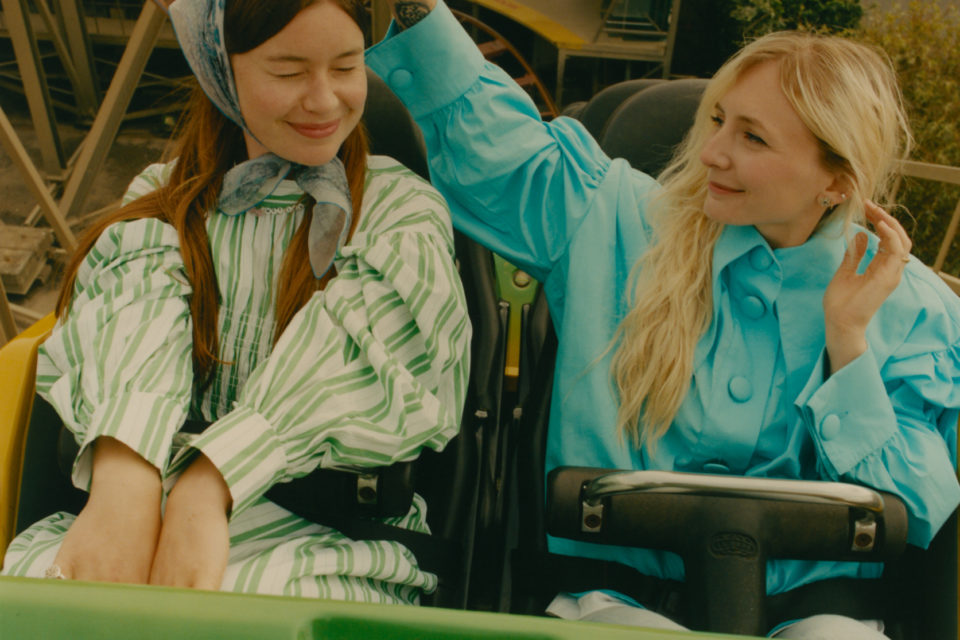Tone of voice and inflection are subtle qualities that can make a world of difference in how songs land. Take those by Wet Leg, a British post-punk duo that’s spent its brief existence delivering deadpan absurdity, deliberate aloofness and airy resignation in tart, tuneful two- to three-minute doses.
Singer Rhian Teasdale and lead guitarist Hester Chambers seem to satirize the self-importance of indie rock band-dom itself. They claim that they started theirs during a semi-sloshed spin on the Ferris wheel, and that they never expected anyone to be interested in the first song they released, last summer’s absurdly apathetic and irresistibly hooky “Chaise Longue.”
At this point, nearly everything is performance for Wet Leg; that goes for Chambers and Teasdale’s beguilingly blithe self-titled debut album, the pastoral outrageousness of their music videos, their first major tour and the interviews they’re giving along the way.
They have a keen eye for the futility and banality of early-ish adulthood — its partying and posturing, its leisurely self-interest, its consumption of self-care products, its obtusely forward come-ons. And they seem to see a similar futility in reflecting too seriously on what they do.
When asked about the emotional subtext beneath the disenchanted surface of their music, Teasdale put a droll stop to all of the abstract talk. “I think it just goes hand-in-hand with our kind of off-the-cuff, on-the-hoof approach,” she mused, seemingly for the benefit of Chambers, seated next to her. “You just kind of, like, sit down to, stand up to or lie down to write a song. You might crouch, squat.” She summed up their approach as “squatting songwriters.”
“The rules are, there ain’t no rules,” is how Chambers described the Wet Leg ethos. Teasdale tacked on an addendum: “Don’t you ever think about anything, ever.” At that, they shared a conspiratorial chuckle.
They actually put quite a bit of craft into their music. Chambers’ guitar lines are angular, insinuating ear worms, and Teasdale is deft at bending melody and mood to slyly accentuate the attitude of a given song. It’s such arch and pleasing stuff that it leaves us little room for indifference.
On the Record: A Q&A with Hester Chambers and Rhian Teasdale of Wet Leg
Jewly Hight: You tried other things and then you wanted to shift direction musically and in the tone of the songwriting and the way that you present it and everything about it. What was that decision about? What made you say, “This is not for me. Wet leg is going to be a much more satisfying and fun pursuit.”
Rhian Teasdale: It wasn’t about saying, “This isn’t for me.” I think when we started Wet Leg, we wanted to just go to some music festivals in the summer, and the tickets are quite expensive. So I guess we just thought about like, “Oh, let’s quickly cobbled together a half-hour set of songs that would be like fun for us to bash out in a festival environment.” And that was as far as our ambition went. So I don’t think we really made any kind of plan to back out of what we were doing before, but it just sort of happened.
Hester Chambers: It was like a natural time to try something new, without the pressure of it being anything
RT: We definitely had like no plans to record anything ever.
JH: I’ve seen you in other interviews be asked about whether the songs are real or fictional. How relevant is that to the way that you think about what you do?
HC: I really think I don’t think about it. The rules are, there are no rules.
RT: Don’t you ever think about anything, ever
HC: But I think that kind of feeling just allows us to make any kind of sound that we feel like at the time.
Yeah, from my perspective, with so much of your lyrics [to Teasdale], they are a reflection of you, in the sense that like “Chaise Longue” is just such a funny, silly three minutes. And then there’s like some songs on that album, which they’re, like, heartbreaking lyrics.
But yeah, we’re just flying by the seat of our pants kind of people, even with our trains of thoughts and emotions and just kind of flowing with it. And over time, I think we both go to a more sound place, where we’re like, “OK, I’m really sad. And that is so fine.” Or, “I’m really grumpy.” And, “Yeah, I might be a bit butthurt, but that’s also fine.”
I don’t know. What am I saying? I’m just rambling. I’m sorry.
JH: You were not in the maybe typical situation where you faced pressure to come up with songs to follow up an initial hit. From what I’ve read, you’d already recorded a lot of this album, or maybe even the entire album, before that. What difference do you think it made that you’d already made all of this music and you weren’t having to figure out what to do next?
HC: We feel very lucky to have been able to do it in this kind of upside down way. Thinking about it now, imagine if “Chaise Longue” had come out before we’d gone in to record the album. How different everything would it be? We wouldn’t have written what we wrote, I think, if we knew that people were actually going to listen to “Chaise Longue.” Maybe we would, but I don’t know.
RT: Yeah, I think at the time we were a bit like, “Oh, this is annoying that we can’t go out and gig, practice playing these songs to audiences. But then it was so good, because we could just incubate everything.
HC: It was a bit scary, though, wasn’t it? Because it felt like there was a lot of faith given to us from Domino and [producer] Dan [Carey].We’re very grateful that there was trust. I think they probably believed in us more than we did that we could do it.
RT: Absolutely. We were just like, you know, that whole “fake it ’til you make it” thing. I mean, it still is, just kind of waiting for someone to be like, “Oh, hang on a minute. This isn’t your tour bus. This is Let Weg’s tour bus. We’ve made a terrible mistake.”
JH: You have possibly introduced some people to the notion of cottagecore as an esthetic, which is a really silly concept. But it is a satisfying thing to see the creativity that you bring to Wet Leg also expand out to the visuals, into what you’ve done with music videos and photos and that side of the presentation of the band, too. And I don’t want to take it overly seriously, but I do wonder if you know if on any level, any aspects of that and the long prairie dresses are kind of messing with symbols of femininity or domesticity or perceptions of what people making indie rock should look like.
RT: Yeah, that’s definitely a thing that we do, and we love a bit of juxtaposition. I was thinking the other day, continuing this discussion of what people should look like, I feel like the way that we are on stage, sometimes we’ll just like do a little pirouette with our guitars and that’s kind of quite traditionally feminine.
HC: We love to spin. [laughter] Ever since we were a little girl.
RT: Butyou know when you you kind of watch people’s like stage personas, you’re kind of tempted to lose the kind of girliness that you might have as part of you.
I think that where rock has been so dominated by by men in the past, and still kind of is actually, and guitar music, I think that you copy your your heroes, right? Like, whether you mean to or not. There’s that whole argument of [the book] Retromania. I think that continues to how you are on stage. It’s kind of like it’s already set how you should be, how you should stand, how you should move on stage. I don’t know why it is, but it’s becoming less and less of a thing now, as we realize that gender is not just man and woman and all of this.
JH: You sometimes shift who or what is carrying the hook. It might be the guitar line carrying the melody while you’re doing a recitation with the vocals. It might be a melodic point-counterpoint between the the vocal parts you’re singing and the guitar lines. You talked about the spontaneity of your process. But when we hear those songs that you’ve recorded, are we hearing playfulness and experimentation and also craft, I mean, the the sharpening of ideas? How does all of that factor into shaping these songs?
HC: Rhian is a melody machine. Quite often she sends a demo over and there will be the melodies of lyrical singing. I’m sure there’s a word for it, when you like, “Doo be doo”? [Teasdale laughs heartily] And then because they’re such fun, hooky melodies, I naturally just lean into accompanying that on the guitar and then maybe use it as a base to move on from and try to add some like more melody somehow.
But as far as craft, personally, I’m flying by the seat of my pants. But it’s fun. I know I’m not a good guitarist, but…
RT: You’re a great guitarist.
JH: Yeah, I think you have great ideas on on guitar, really memorable lines and textures.
RT: And there is a lot of craft that goes into it when we’re like, “Oh, what should we put here?” We’ll record everything and then we’ll go back and listen to it and we’ll be like, “This bit, this is the line.” And that is what I think is the definition of craft, putting work into something. [laughs again]

